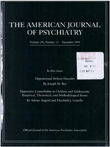Not all that moves is tardive dyskinesia
Abstract
OBJECTIVE: Because tardive dyskinesia and spontaneous dyskinesia appear the same, it is difficult to determine whether an individual patient's abnormal movements are induced by medication or have developed spontaneously. Therefore, estimates of the prevalence of tardive dyskinesia that are based on observations not adjusted for spontaneous dyskinesia are inflated. In addition, age is thought to be an important risk factor in the development of both tardive and spontaneous dyskinesias. The authors estimate the prevalence of both disorders for specific age groups. METHOD: The authors reviewed nine reports on dyskinesia prevalence that included history of neuroleptic treatment and related prevalence to age. A rating of 2 or more on the Abnormal Involuntary Movement Scale or an equivalent score on another scale was considered an indication of dyskinesia. If the subject had taken neuroleptics for more than 3 months, the movement disorder was classified as neuroleptic-associated dyskinesia; other dyskinesias were considered spontaneous. The prevalence of tardive dyskinesia was defined as the rate of neuroleptic-associated dyskinesia minus the rate of spontaneous dyskinesia. RESULTS: The true rate of tardive dyskinesia was below 20% for all age groups except 70-79 years. The correlation between the rate of neuroleptic-associated dyskinesia and the rate of spontaneous dyskinesia was low. CONCLUSIONS: After age 40 the prevalence of spontaneous dyskinesia is sufficiently high to conclude that many patients with diagnoses of tardive dyskinesia have abnormal movements attributable to causes other than neuroleptics.
Access content
To read the fulltext, please use one of the options below to sign in or purchase access.- Personal login
- Institutional Login
- Sign in via OpenAthens
- Register for access
-
Please login/register if you wish to pair your device and check access availability.
Not a subscriber?
PsychiatryOnline subscription options offer access to the DSM-5 library, books, journals, CME, and patient resources. This all-in-one virtual library provides psychiatrists and mental health professionals with key resources for diagnosis, treatment, research, and professional development.
Need more help? PsychiatryOnline Customer Service may be reached by emailing [email protected] or by calling 800-368-5777 (in the U.S.) or 703-907-7322 (outside the U.S.).



